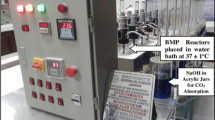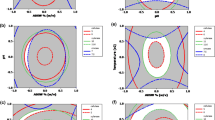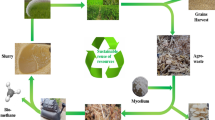Abstract
This study describes the extraction and characterization of the hemicellulosic autohydrolysates (HAHs) derived from rice straw (RS) and vascular aquatic weeds like Typha angustifolia (TA) and Ceretophyllum demersum (CD). It further explores their capacity to sustain the proliferation of selected lactic acid bacteria (i.e., prebiotic activity) isolated from milk samples. To fractionate HAH from RS, TA and CD hot water extraction (HWE) method was used and RS, TA, and CD biomasses yielded 6.8, 4.99 and 2.98% of HAH corresponding to the hemicellulose extraction efficiencies of 26.15 ± 0.8%, 23.76 ± 0.6%, and 18.62 ± 0.4% respectively. The chemical characterization of HAH concentrates through HPLC showed that they comprised galactose, arabinose, xylose and glucose. The total phenol content of the RS, TA and CD-derived HAH concentrates were 37.53, 56.78 and 48.08 mg GAE/g. The five lactic acid bacteria (LAB) isolates Q1B, Q2A, Q3B, G1C and G2B selected for prebiotic activity assays generated mixed responses with the highest growth in RS-HAH for Q2A and the least in TA-HAH for Q3B. Further, the isolates Q2A, Q3B, G1C, and G2B, which showed the highest growth performance, were identified through MALDI-TOF and 16S rRNA sequencing as Lactobacillus brevis. All the tested LAB isolates showed diauxic growth in crude HAH preparations to maximize the utilization of carbon resources for their proliferation. This suggests that the selected LAB isolates are efficient degraders of hemicellulosic sugars. This paves the way for the valorization of lignocellulosic biomass to produce prebiotic hemicellulosic autohydrolysate and consequently enhances environmental sustainability by improving resource efficiency.



Similar content being viewed by others
Availability of data and materials
All data generated or analysed during this study are included in this published article and its supplementary information files.
References
Abdel-Rahman MA, Tashiro Y, Sonomoto K (2011) Lactic acid production from lignocellulose-derived sugars using lactic acid bacteria: Overview and limits. J Biotechnol 156:286–301. https://doi.org/10.1016/J.JBIOTEC.2011.06.017
Abdel-Rahman MA, Hassan SED, Fouda A, Radwan AA, Barghoth MG, Desouky SG (2021) Evaluating the effect of lignocellulose-derived microbial inhibitors on the growth and lactic acid production by Bacillus coagulans Azu-10. Ferment 7(1):1–17. https://doi.org/10.3390/FERMENTATION7010017
AOAC (2000) Official methods of analysis of the Association of Official Analytical Chemists International. AOAC International, Gaithersburg, Maryland, USA
Bansal S, Lishawa SC, Newman S, Tangen BA, Wilcox D, Albert D, Anteau MJ, Cressey RL, DeKeyser E, Elgersma KJ (2019) Typha (Cattail) invasion in North American wetlands: biology, regional problems, impacts, ecosystem services, and management. Wetlands 39:645–684. https://doi.org/10.1007/S13157-019-01174-7
Batalha LAR, Han Q, Jameel H, H-min C, Colodette JL, Borges Gomes FJ (2015) Production of fermentable sugars from sugarcane bagasse by enzymatic hydrolysis after autohydrolysis and mechanical refining. Bioresour Technol 180:97–105. https://doi.org/10.1016/J.BIORTECH.2014.12.060
Bhattacharyya P, Bhaduri D, Adak T, Munda S, Satapathy BS, Dash PK, Padhy SR, Pattanayak A, Routray S, Chakraborti M, Baig MJ, Mukherjee AK, Nayak AK, Pathak H (2020) Characterization of rice straw from major cultivars for best alternative industrial uses to cut off the menace of straw burning. Ind Crops Prod 143:111919. https://doi.org/10.1016/J.INDCROP.2019.111919
Bhattacharyya P, Bisen J, Bhaduri D, Priyadarsini S, Munda S, Chakraborti M, Adak T, Panneerselvam P, Mukherjee AK, Swain SL, Dash PK, Padhy SR, Nayak AK, Pathak H, Arora S, Nimbrayan P (2021) Turn the wheel from waste to wealth: Economic and environmental gain of sustainable rice straw management practices over field burning in reference to India. Sci Total Environ 775:145896. https://doi.org/10.1016/J.SCITOTENV.2021.145896
Cappuccino JG, Sherman N (2013) Microbiology A Laboratory Manual, 10th edn. Pearson Education Limited, London
Chandel AK, Garlapati VK, Singh AK, Antunes FAF, da Silva SS (2018) The path forward for lignocellulose biorefineries: Bottlenecks, solutions and perspective on commercialization. Bioresour Technol 264:370–381. https://doi.org/10.1016/J.BIORTECH.2018.06.004
Dahmen N, Lewandowski I, Zibek S, Weidtmann A (2019) Integrated lignocellulosic value chains in a growing bioeconomy: Status quo and perspectives. GCB Bioenergy 11:107–117. https://doi.org/10.1111/GCBB.12586
Davani-Davari D, Negahdaripour M, Karimzadeh I, Seifan M, Mohkam M, Masoumi SJ, Berenjian A, Ghasemi Y (2019) Prebiotics: Definition, types, sources, mechanisms and clinical applications. Foods 8(3):1–27. https://doi.org/10.3390/FOODS8030092
Felsenstein J (1985) Confidence limits on phylogenies: an approach using the bootstrap. Evolution (N Y) 39:783. https://doi.org/10.2307/2408678
Gallina G, Cabeza A, Grenman H, Grenman H, Biasa P, Garcia-Serna J, Salmi T (2018) Hemicellulose extraction by hot pressurized water pretreatment at 160 °C for 10 different woods: Yield and molecular weight. J Supercrit Fluids 133:716–725. https://doi.org/10.1016/J.SUPFLU.2017.10.001
Geng W, Venditti RA, Pawlak JJ, Chang HM (2018) Effect of delignification on hemicellulose extraction from switchgrass, poplar and pine and its effect on enzymatic convertibility of cellulose-rich residues. BioRes 13:4946–4963. https://doi.org/10.15376/BIORES.13.3.4946-4963
Gullón P, Moura P, Esteves MP, Girio FM, Dominguez H, Parajo JC (2008) Assessment on the fermentability of xylooligosaccharides from rice husks by probiotic bacteria. J Agric Food Chem 56:7482–7487. https://doi.org/10.1021/JF800715B
Haga H, Ishikawa K (2014) Spatial distribution of submerged macrophytes in the south basin of Lake Biwa in the summer of 2012, compared with 2002 and 2007. Jpn J Limnol 75:107–111. https://doi.org/10.3739/RIKUSUI.75.107
Hong C, Corbett D, Venditti R, Jameel H, Park S (2019) Xylooligosaccharides as prebiotics from biomass autohydrolyzate. Lwt 111:703–710. https://doi.org/10.1016/j.wt.2019.05.098
Huang C, Yu Y, Li Z, Yan B, Pei W, Wu H (2022) The preparation technology and application of xylo-oligosaccharide as prebiotics in different fields: A review. Front Nutr 9:996811. https://doi.org/10.3389/fnut.2022.996811
Kajikawa A, Midorikawa E, Masuda K, Kondo K, Irisawa T, Igimi S, Okada S (2016) Characterization of flagellins isolated from a highly motile strain of Lactobacillus agilis. BMC Microbiol 16:1–8. https://doi.org/10.1186/S12866-016-0667-X/FIGURES/6
Kandler O (1983) Carbohydrate metabolism in lactic acid bacteria. Antonie Van Leeuwenhoek 49:209–224. https://doi.org/10.1007/BF00399499
Kilpeläinen PO, Hautala SS, Byman OO, Tanner LJ, Korpinen RI, Lillandt MKJ, Pranovich AV, Kitunen VH, Willifor SM, Iivesniemi HS (2014) Pressurized hot water flow-through extraction system scale up from the laboratory to the pilot scale. Green Chem 16:3186–3194. https://doi.org/10.1039/C4GC00274A
Kim Y, Hendrickson R, Mosier NS, Ladisch MR (2009) Liquid hot water pretreatment of cellulosic biomass. Methods Mol Biol 581:93–102. https://doi.org/10.1007/978-1-60761-214-8_7
Kowalczyk M, Cocaign-Bousquet M, Loubiere P, Bardowski J (2008) Identification and functional characterisation of cellobiose and lactose transport systems in Lactococcus lactis IL1403. Arch Microbiol 189:187–196. https://doi.org/10.1007/S00203-007-0308-8
Koyama M, Yamamoto S, Ishikawa K, Ban S, Toda T (2014) Anaerobic digestion of submerged macrophytes: chemical composition and anaerobic digestibility. Ecol Eng 69:304–309. https://doi.org/10.1016/j.ecoleng.2014.05.013
Kumar S, Stecher G, Li M, Knyaz C, Tamura K (2018) MEGA X: Molecular evolutionary genetics analysis across computing platforms. Mol Biol Evol 35:1547–1549. https://doi.org/10.1093/molbev/msy096
Lasrado LD, Gudipati M (2013) Purification and characterization of β-d-xylosidase from Lactobacillus brevis grown on xylo-oligosaccharides. Carbohydr Polym 92:1978–1983. https://doi.org/10.1016/J.CARBPOL.2012.11.081
Lawley B, Sims IM, Tannock GW (2013) Whole-transcriptome shotgun sequencing (RNA-seq) screen reveals upregulation of cellobiose and motility operons of Lactobacillus ruminis L5 during growth on tetrasaccharides derived from barley β-glucan. Appl Environ Microbiol 79:5661–5669. https://doi.org/10.1128/AEM.01887-13
Lian Z, Zhang Q, Xu Y, Zhou X, Jiang K (2022) Biorefinery cascade processing for converting corncob to xylooligosaccharides and glucose by maleic acid pretreatment. Appl Biochem Biotechnol 194(10):4946–4958. https://doi.org/10.1007/s12010-022-023985-7
Licandro-Seraut H, Scornec H, Pedron T, Cavin JF, Sansonetti PJ (2014) Functional genomics of Lactobacillus casei establishment in the gut. Proc Natl Acad Sci U S A 111(30):E3101–E3109. https://doi.org/10.1073/PNAS.1411883111
Lira C (2018) Autohydrolysis pretreatment of mixed lignocellulosic biomass. Dissertation, The University of Western Ontario (Canada)
Liu Q, Labbé N, Adhikari S, Chmely SC, Abdoulmoumine N (2018) Hot water extraction as a pretreatment for reducing syngas inorganics impurities – A parametric investigation on switchgrass and loblolly pine bark. Fuel 220:177–184. https://doi.org/10.1016/J.FUEL.2018.01.108
Lolou V, Panayiotidis MI (2019) Functional role of probiotics and prebiotics on skin health and disease. Ferment 5(2):1–41. https://doi.org/10.3390/FERMENTATION5020041
Mahroof M (2022) Substrate utilization preferences and antibiotic susceptibility pattern in lactic acid bacteria isolated from milk samples. Dissertation, University of Kashmir, India
Maria A, Margarita T, Iilia I, Iskra I (2014) Gene expression of enzymes involved in utilization of xylooligosaccharides by Lactobacillus strains. Biotechnol Biotechnol Equip 28(5):941–948. https://doi.org/10.1080/13102818.2014.948257
Mokrzycki J, Michalak I, Rutkowski P (2021) Biochars obtained from freshwater biomass—green macroalga and hornwort as Cr (III) ions sorbents. Biomass Convers Biorefin 11:301–313. https://doi.org/10.1007/s13399-020-00649-6
Munoz Escobar M, Voyevoda M, Fuhner C, Zehnsdorf A (2011) Potential uses of Elodea nuttallii-harvested biomass. Energy Sustain Soc 1:1–8. https://doi.org/10.1186/2192-0567-1-4/TABLES/2
Nasiri H, Forouzandeh M, Rasaee MJ, Rahbarizadeh F (2005) Modified salting-out method: high-yield, high-quality genomic DNA extraction from whole blood using laundry detergent. J Clin Lab Anal 19:229–232. https://doi.org/10.1002/JCLA.20083
Neville BA, Forde BM, Claesson MJ, Darby T, Coghlan A, Nally K, Ross RP, O’Toole PW (2012) Characterization of pro-inflammatory flagellin proteins produced by Lactobacillus ruminis and related motile Lactobacilli. PLoS One 7(7):e40592. https://doi.org/10.1371/JOURNAL.PONE.0040592
O’Sullivan C, Rounsefell B, Grinham A, Clarke W, Udy J (2010) Anaerobic digestion of harvested aquatic weeds: water hyacinth (Eichhornia crassipes), cabomba (Cabomba Caroliniana) and salvinia (Salvinia molesta). Ecol Eng 36:1459–1468. https://doi.org/10.1016/J.ECOLENG.2010.06.027
Okano K, Yoshida S, Yamada R, Tanaka T, Ogino C, Fukuda H, Kondo A (2009) Improved production of homo-D-lactic acid via xylose fermentation by introduction of xylose assimilation genes and redirection of the phosphoketolase pathway to the pentose phosphate pathway in L-Lactate dehydrogenase gene-deficient Lactobacillus plantarum. Appl Environ Microbiol 75:7858–7861. https://doi.org/10.1128/AEM.01692-09
Palmqvist E, Hahn-Hägerdal B (2000) Fermentation of lignocellulosic hydrolysates. II: inhibitors and mechanisms of inhibition. Bioresour Technol 74:25–33. https://doi.org/10.1016/S0960-8524(99)00161-3
Patel A, Shah AR (2021) Integrated lignocellulosic biorefinery: Gateway for production of second generation ethanol and value-added products. J Bioresour Bioprod 6:108–128. https://doi.org/10.1016/J.JOBAB.2021.02.001
Phaiboonsilpa N, Chysirichote T, Champreda V, Laosiripojana N (2020) Fermentation of xylose, arabinose, glucose, their mixtures and sugarcane bagasse hydrolyzate by yeast Pichia stipitis for ethanol production. Energy Rep 6:710–713. https://doi.org/10.1016/J.EGYR.2019.11.142
Pham VT, Seifert N, Richard N, Raederstorff D, Steinert R, Prudence K, Hasan Moharjeri M (2018) The effects of fermentation products of prebiotic fibres on gut barrier and immune functions in vitro. PeerJ 6:e5288. https://doi.org/10.7717/PEERJ.5288
Phutela UG, Dar RA (2014) Role of lignocellulolytic thermophilic fungus Thermoascus aurantiacus MTCC 375 in paddy straw digestibility and its implication in biogas production. Afr J Microbiol Res 8(17):1798–1802. https://doi.org/10.5897/AJMR2013.6425
Pourabedin M, Zhao X (2015) Prebiotics and gut microbiota in chickens. FEMS Microbiol Lett 362(15):fnv122. https://doi.org/10.1093/FEMSLE/FNV122
Rajan K, Carrier DJ (2016) Insights into exo-cellulase inhibition by the hot water hydrolyzates of rice straw. ACS Sustain Chem Eng 4:3627–3633. https://doi.org/10.1021/ACSSUSCHEMENG.5B01778/ASSET/IMAGES/MEDIUM/SC-2015-01778F_0004.GIF
Rajan K, D’Souza DH, Kim K, Choi JM, Elder CDJ, Labbe N (2021) Production and characterization of high-value prebiotics from biorefinery-relevant feedstocks. Front Microbiol 12:998. https://doi.org/10.3389/FMICB.2021.675314/BIBTEX
Rani BSJ, Venkatachalam S (2022) A neoteric approach for the complete valorization of Typha angustifolia leaf biomass: A drive towards environmental sustainability. J Environ Manag 318:115579
Rusanen A, Lappalainen K, Karkkainen J, Tuuttila T, Mikola M, Lassi U (2019) Selective hemicellulose hydrolysis of Scots pine sawdust. Biomass Convers Biorefin 9:283–291. https://doi.org/10.1007/S13399-018-0357-Z/FIGURES/4
Saitou N, Nei M (1987) The neighbor-joining method: a new method for reconstructing phylogenetic trees. Mol Biol Evol 4:406–425. https://doi.org/10.1093/OXFORDJOURNALS.MOLBEV.A040454
Sankar MK, Ravikumar R, Kumar MN, Sivakumar U (2018) Development of co-immobilized tri-enzyme biocatalytic system for one-pot pretreatment of four different perennial lignocellulosic biomass and evaluation of their bioethanol production potential. Bioresour Technol 269:227–236. https://doi.org/10.1016/j.biotech.2018.08.091
Sluiter JB, Ruiz RO, Scarlata CJ, Sluiter AD, Templeton DW (2010) Compositional analysis of lignocellulosic feedstocks. 1. Review and description of methods. J Agric Food Chem 58:9043–9053. https://doi.org/10.1021/JF1008023/SUPPL_FILE/JF1008023_SI_007.PDF
Takkellapati S, Li T, Gonzalez MA (2018) An overview of biorefinery derived platform chemicals from a cellulose and hemicellulose biorefinery. Clean Technol Environ Policy 20:1615. https://doi.org/10.1007/S10098-018-1568-5
Tamura K, Peterson D, Peterson N, Stecher G, Nei M, Kumar S (2011) MEGA5: Molecular evolutionary genetics analysis using maximum likelihood, evolutionary distance, and maximum parsimony methods. Mol Biol Evol 28:2731–2739. https://doi.org/10.1093/molbev/msr121
Tramontina R, Brenelli LB, Sousa A, Alves R, Arenas AMZ, Squina FM (2020) Designing a cocktail containing redox enzymes to improve hemicellulosic hydrolysate fermentability by microorganisms. Enzyme Microb Technol 135:109490. https://doi.org/10.1016/j.enzmictec.2019.109490
Van Hung N, Maguyon-Detras MC, Migo MV, Quilloy R, Balingbing C, Chivenge P, Gummert M (2020) Rice straw overview: availability, properties, and management practices. In: Gummert M, Hung N, Chivenge P, Douthwaite B (eds) Sustainable Rice Straw Management, 3rd edn. Springer, Cham, pp 1–13. https://doi.org/10.1007/978-3-030-32373-8_1
Wang J, Boy R, Nguyen NA, Keum JK, Cullen DA, Chen J, Soliman M, Littrel KC, Harper D, Tetard T, Rials TG, Naskar AK, Labbe N (2017) Controlled assembly of lignocellulosic biomass components and properties of reformed materials. ACS Sustain Chem Eng 5:8044–8052. https://doi.org/10.1021/ACSSUSCHEMENG.7B01639/SUPPL_FILE/SC7B01639_SI_001.PDF
Wells JM, Drielak E, Surendra KC, Kumar Khanal S (2020) Hot water pretreatment of lignocellulosic biomass: Modeling the effects of temperature, enzyme and biomass loadings on sugar yield. Bioresour Technol 300:122593. https://doi.org/10.1016/J.BIORTECH.2019.122593
Xue S, Jones AD, Sousa L, Piotrowski J, Jin M, Sarks C, Balan V (2018) Water-soluble phenolic compounds produced from extractive ammonia pretreatment exerted binary inhibitory effects on yeast fermentation using synthetic hydrolysate. PLoS One 13(3):e0194012. https://doi.org/10.1371/journal.pone.0194012
Yadav M, Paritosh K, Chawade A, Pareek N, Vivekanand V (2018) Genetic engineering of energy crops to reduce recalcitrance and enhance biomass digestibility. Agriculture 8(6):76. https://doi.org/10.3390/AGRICULTURE8060076
Yamakawa CK, D’Imperio I, Bonfiglio F, Mussatto SI (2022) Valorization of Pinus taeda hemicellulosic hydrolysate for the production of value-added compounds in an ethanol biorefinery. Fuel 318:123489. https://doi.org/10.1016/j.fuel.2022.123489
Yan L, Ma R, Li L, Fu J (2016) Hot water pretreatment of lignocellulosic biomass: An effective and environmentally friendly approach to enhance biofuel production. Chem Eng Technol 39:1759–1770. https://doi.org/10.1002/CEAT.201600394
Yan F, Tian S, Chen H, Gao S, Dong X, Du K (2022) Advances in xylooligosaccharides from grain byproducts: Extraction and prebiotic effects. Grain Oil Sci Technol 5(2):98–106. https://doi.org/10.1016/j.gaost.2022.02.002
Acknowledgements
The authors are thankful to the Centre of Research for Development (CORD), University of Kashmir, Srinagar, Jammu and Kashmir for providing the necessary facilities to carry out the research work. We acknowledge and appreciate Dr. Harsh Panwar from GADVASU, Ludhiana for helping us make the MALDI-TOF facility available and the Department of Food Science and Technology, University of Kashmir for facilitating the freeze-drying of the samples.
Funding
The authors declare that the work was carried out of the sanctioned budget of the department and no other external funds or grants were received during the preparation of this manuscript.
Author information
Authors and Affiliations
Contributions
The author Rouf Ahmad Dar contributed to the study conceptualization and design. Methodology, formal analysis and data collection were performed by Mawish Mahroof. The first draft of the manuscript was written by Mawish Mahroof and Rouf Ahmad Dar, and all the authors commented on previous versions of the manuscript. The resources were provided by Rouf Ahmad Dar, Ruqeya Nazir and Md. Niamat Ali. The work was supervised by Rouf Ahmad Dar and Ruqeya Nazir. All authors worked on the manuscript revision and finalization. All authors read and approved the final manuscript.
Corresponding author
Ethics declarations
Ethical approval and Consent to participate
Not applicable.
Consent for publication
Not applicable.
Competing interest
The authors hereby declare that they have no competing interests.
Additional information
Responsible Editor: Ta Yeong Wu
Publisher's Note
Springer Nature remains neutral with regard to jurisdictional claims in published maps and institutional affiliations.
Supplementary Information
Below is the link to the electronic supplementary material.
Rights and permissions
Springer Nature or its licensor (e.g. a society or other partner) holds exclusive rights to this article under a publishing agreement with the author(s) or other rightsholder(s); author self-archiving of the accepted manuscript version of this article is solely governed by the terms of such publishing agreement and applicable law.
About this article
Cite this article
Mahroof, M., Dar, R.A., Nazir, R. et al. Valorization of rice straw and vascular aquatic weeds for sustainable prebiotic hemicellulosic autohydrolysate production: Extraction, characterization and fermentability. Environ Sci Pollut Res 31, 35744–35759 (2024). https://doi.org/10.1007/s11356-024-33611-4
Received:
Accepted:
Published:
Issue Date:
DOI: https://doi.org/10.1007/s11356-024-33611-4




